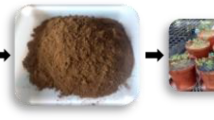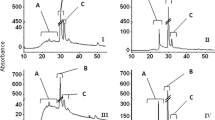Abstract
After a short review about the possibilities of inhibition of nitrification on the nitrogen nutrition of plants and on their composition, it is reported about investigations with oxidative ammonified lignin sulfonates from liquor of the paperindustry (N-Lignin) on metabolism and yield of spinach and rey grass.
N-Lignin inhibits the nitrification dependent on its concentration, on soil temperature and on the activity of soil microorganisms. The inhibition diminishes the content of nitrate in plants. In the case of a nearly complete inhibition of nitrification a decrease of yield occurs. This may be caused by a change of metabolic processes.
The course of mineralisation of organic bound nitrogen in N-Lignin influences its availibility by plants in such a way, that a positive effect on yield production and a lower nitrate content of plants can be observed.
Also the content of potassium decreases with inhibition of nitrification, whilst the content of phosphat is increased. The increase in phosphat content may be also partly due to the organic constituents of N-Lignin, which increase the availibility of soil phosphate.
Zusammenfassung
Nach einer kurzen Übersicht über die Möglichkeiten einer Hemmung der Nitrifizierung und die sich daraus ergebenden Konsequenzen für die Stickstoffernährung der Pflanze und ihre Zusammensetzung, wird über Versuche mit oxidativ ammonifizierten ligninhaltigen Ablaugen der Zellstoffindustrie (N-Lignin) berichtet.
N-Lignin hemmt in Abhängigkeit von der Konzentration, von der Bodentemperatur und der mikrobiellen Aktivität des Bodens die Nitrifizierung. Diese Hemmung führt zu einer Verminderung des Nitratgehaltes in Spinat und deutschem Weidelgras. Bei starker Hemmung der Nitrifizierung werden Mindererträge erzielt, die wahrscheinlich auf Störungen im Stoffwechsel zurückzuführen sind.
Ein günstiger Einfluß auf die Ertragsbildung und den Nitratgehalt scheint durch eine langsamere Anlieferung von Stickstoff aus dem N-Lignin auch bei höherer Düngung gegeben zu sein.
Bei gehemmter Nitrifizierung nimmt der Gehalt an Kalium in den Pflanzen ab, der Gehalt an Phosphat steigt an. Diese Steigerung wird aber zumindest zu einem Teil auch durch die organischen Anteile des N-Lignins, die eine bessere Verfügbarkeit der Phosphorsäure bewirken, bedingt.
Resume
L'introduction traite des modifications que la nitrification entraine dans le sol, ainsi que la possibilité de fixation et de déplacement des formes de l'azote. Des modifications liées à ces phénomènes en découlent pour la nutrition des végétaux et l'accumulation des substances — a l'intérieur de la plante. La répercussion de ces faits sur la qualité des végétaux est évoquée.
On compare, la minéralisation et la nitrification de l'azote lié aux eaux résiduaires riches en lignines de l'industrie de la cellulose (N-lignine), qui subit une ammonification oxydative, avec le comportement du sulfate d'ammoniaque et de la floranide (BASF), et de dans deux sols différents (une terre noire à pseudogley et un sol brun). Les relations de ces phénomènes avec la température sont décrites.
La fumure à base de lignine azotée détermine une inhibition de la nitrification, ce qui retentit sur le rendement de l'epinard et de l'herbe. Les taux d'azote nitriques de P et de K sont modifiés.
Similar content being viewed by others
Literatur
Aleem, M.I.H., M.S. Engel & M. Alexander (1957) The inhibition of nitrification by ammonia.Proc. Soc. Amer. Bacteriol. 9
Bauer, K.H. (1950) Die organische Analyse. Leipzig, 407.
Beevers, L. & R.H. Hagemann (1969) Nitrate reduction in higher plants.Ann. Rev. Plant Physiol. 20:495–522.
Bengtsson, B.L. (1968) Effect on nitrification inhibitor on yield and nitrate content of spinach.Z. Pflanzenernähr. 121:1–4.
Bernt, E. & H.U. Bergmeyer (1962) Die enzymatische Analyse. Verlag Chemie, 402–406.
Bremner, J.M. (1965) Inorganic forms of nitrogen. In: Black, C.A.: Methods of soil analysis. Part 2. Amer. Soc. Agron. Madison, Wisc. USA, 1179–1237.
Broadbent, F.E. & K.B. Tyler (1957) Nitrification of ammoniacal fertilizers in some California soils.Hilgardia 27:247–267.
Chouteau, J. (1963) Etude de la nutrition nitrique et ammoniacale de la plante de tabac en présence des doses croissantes de bicarbonate dans le milieu nutritif.Ann. inst. exp. tabac de Bergerac IV: Nr. 2.
Coic. Y., Ch. Lesaint & F. Leroux (1962) Effects de la nature ammoniacale ou nitrique de l'alimentation azotée et du changement de la nature de cette alimentation sur la metabolisme des anions et cations chez la tomate.Ann. Physiol. végét. 4:117.
Dijkshoorn, W. (1962) Metabolic regulation of the alkaline effect of nitrate in utilization in plants.Nature 194:165–167.
Flaig, W. & H. Söchtig (1967) Organische Verbindungen als Stickstoffquelle für die Ernährung der Pflanzen.Anales de Edafologia y Agrobiologia 26:801–828.
Goring, C.A.I. (1962a) Control of nitrification by 2-chloro-6-(trichlormethyl)-pyridine.Soil. Sci. 93:211–218.
Goring, C.A.I. (1962b) Control of nitrification of ammonium fertilizers and urea by 2-Chloro-6-(trichloromethyl)pyridine.Soil Sci. 93:431–439.
Jackson, M.L. (1958) Soil chemical analysis. Constable and Co. London, S. 197 ff.
Jacob, A. & K. Wiegand (1952) Umsetzung des mineralischen Stickstoffs der Düngemittel im Boden.Z. Pflanzenernähr. 59:48–60.
Jungk, A. (1967) Einfluß von Ammonium- und Nitrat-Stickstoff auf das Kationen-Anionen-Gleichgewicht in Pflanzen und seine Beziehung zum Ertrag.Landwirtsch. Forsch. 21: Sonderheft:50–63.
Khadr, A.H., P.C. DeKock & A. Wallace (1966) Malic and citric acids of trifoliate organe and rough lemon as influenced by ammonium, nitrate, or urea as sources of nitrogen. Current topics in plant nutrition. Los Angeles, California, 38–40.
Kirkby, E.A. (1967) A note on the utilization of nitrate, urea and ammonium nitrogen byChenopodium album.Z. Pflanzenernähr. 117:204–209.
Kirkby, E.A. & K. Mengel (1967) The ionic balance in different tissues of tyomato plants in relation to nitrate, urea or ammonium nutrition.Plant Physiol. 42:6–14.
Lakhdive, B.A. & R. Prasad (1969) Wirkung von Harnstoff unter Zusatz von nitrifikationshemmenden Substanzen auf Stickstoffaufnahme und Ertrag von Reis in Abhängigkeit von der Placierung des Düngers und der Düngezeit.Z. Pflanzenernähr. 124:23–29.
Meikle, R.W. & C.T. Redemann (1966) Tracer study of 6-chloro-picolinic acid in corn.J. Agric. Food Chem. 14:159–161.
Michael, G., H. Schuhmacher & H. Marschner (1965) Aufnahme von Ammoniumund Nitratstickstoff aus markiertem Ammoniumnitrat und deren Verteilung in der Pflanze.Z. Pflanzenernähr. 110:225–238.
Pirschle, K. (1931) Nitrate und Ammonsalze als Stickstoffquellen für höhere Pflanzen bei konstanter Wasserstoffionen-konzentration.Planta 14:583.
Prjanischnikow, D.N. (1952) Der Stickstoff im Leben der Pflanzen und im Ackerbau der UdSSR. Akad. Verl. Berlin.
Quastel, J.H. (1965) Soil metabolism.Ann. Rev. Plant Physiol. 16:217–240.
Redemann, C.T. R.T. Martin, J.D. Wien & J.G. Widofsky (1965) Tracer study of residues from 2-chloro-6-(trichloro-methyl)pyridine in plants.J.Agric. Food Chem. 13:518–521.
Riehle, G. & J. Jung (1966) Zum Vorgang der Nitritbildung im Spinat.Landwirtsch. Forsch. 19:231–242.
Schuphan, W. (1965) Ertragsbildung und Erzeugung wertgebender Inhalts- und Schadstoffe in Abhängigkeit von der N- und P-Düngung.Landwirtsch. Forsch. 19. Sonderhelt:193–205.
Söchtig, H. (1967) About the influence of humic substances on the nitrification and the uptake of nitrate by plants. Studies about Humus.Trans. Int. Symp. “Humus et Planta IV” Prague, Sept.1967:293–296.
Sommer, K. (1969) Wachstums- und Ertragsbeeinflussung bei Weidelgras durch die Anwendung von Pflanzenschutzmitteln.Landwirtsch. Forsch. 22:64–69.
Vielemeyer, H.P. & P. Seyfarth (1965) Ein Beitrag zur Nitratbestimmung in Pflanzenmaterial und einige erste Ergebnisse.Albrecht-Thaer-Archiv 9:813–822.
Wallace, A. (1966) Anion and ammonium nitrogen effects on Rb 86 and K 42 accumulation and translocation by bush bean plants. Current topics of plant nutrition. Los Angeles, California 94–98.
Author information
Authors and Affiliations
Additional information
Vortrag vor der Deutschen Gesellschaft für Qualitätsforschung in Geisenheim am 8. April 1970.
Rights and permissions
About this article
Cite this article
Söchtig, H. Über den Einfluss von N-Lighin auf die Nitrifizierung im Boden sowie den Ertrag und den Nitratgehalt der Pflanzen. Plant Food Hum Nutr 20, 137–150 (1970). https://doi.org/10.1007/BF01100358
Issue Date:
DOI: https://doi.org/10.1007/BF01100358




